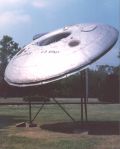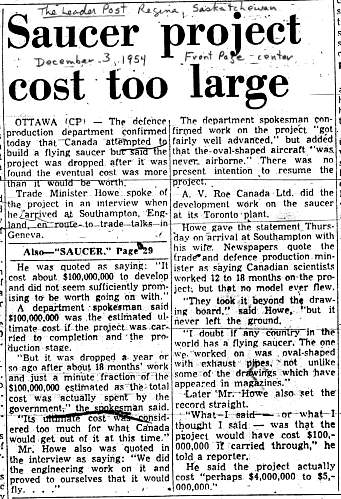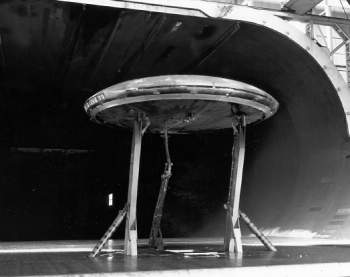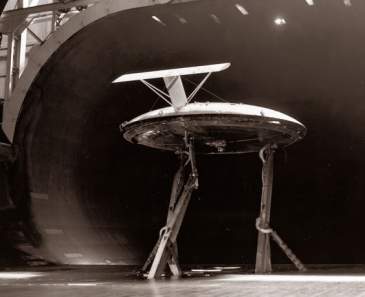A report on the existence of the American Project Silverbug was declassified on March 29, 1995 at the request of ufologists. Some ufologists and skeptics were amazed to note that a "such secrecy could have been maintained for 45 years " (Today some say "more than 50 years.")
The concept was by an English aeronautical engineer John Frost, aged 31, who had left de Havilland in England because the economic context did not allow to risk any money in unorthodox designs. His latest realization was the de Havilland 108, a quite unconventional yet successful plane. In Canada, after having been bored with the development of the very conventional EC 100 jet fighter, he thought about those widely reported "Russian or Martian" flying saucers and in 1953 he proposed to design Canadian flying saucer, baptized Avrocar.

|
Above: One of the two prototypes is now standing in front the school of the Army Air Transport in Fort Monroe, Virginia.
Later, in 1960, advertising booklets were prepared by Avro, announcing not only the Avrocar revolution, but also an Avrowagon for the whole family, an Avroangel as flying ambulance, an Avropelican for rescue missions etc. Avro's intention was to massively distribute these booklets to potential customers, civil and military.
Unfortunately the Avrocar which was intended to be "supersonic," proved with its first "flight" in 1960 to have the performances and the maneuverability of a hovercraft without skirts: crashing to the ground at every reasonable manoeuver attempt, and not rising more than 2 and a half meters, totally unpredictable as soon as the flow of its turbine did not benefit anymore from ground effects. In addition, the structure had an annoying tendency to quickly melt in its overheated center. And of course, the surrealistic goal of a Mach III speed was long gone. This is why these booklets were never distributed, which barely qualifies as "a secrecy firmly maintained for 50 years."
There was actually no lasting secret about the Avrocar, as a quick tour of the Press indicates. A soon as 1954, numerous front page articles discussed the Avrocar fiasco, and the public concern over budgets wasted in the inefficient concept which never flew.

|
Above is the center of the front page of The Leader Post, Regina, Saskatchevan, Canada, December 3, 1954.
Canadian defense confirms to the Press that canada attempted to build a flying saucer but gave up because the investiment revealed unjustified. The minister of Defense and Trade discusses the matter in an interview in a foreign country. Only a tiny fraction of the budget was necessary to understand that it can only be a fiasco. Canada proved itself that it could fly, but it never flew, it never left the ground, and the minister thinks that no other country has ever built a successful flying saucer.
It is possible to imagine that the Secretary for Trade lied (but for what purpose?), but it is intolerable to say that the Canadian project had been so secret that it took 50 years to learn its the existence.
This was a local newspaper, but the similar article appeared elsewhere, for example in the Toronto Star. In June 1955, the American "Look" magazine published a long article. Brigadier General Benjamin Kelsey, deputy manager of the US Air Force research and development, revealed the invaluable secrecy: the Air Force will study a project of a flying saucer. He gives great details about the expected performances and a faithful description of the Avrocar, without mentionning the project's name because that was not the point.
On September 15, 1953, the New York Times published an article about the visit of Lieutenant-Gen. Donald Putt of the US ARDC at the Avro plant in Malton, and its favorable impression about the "Project Y," the first model of for the Avrocar.
In 1959 a private pilot, Jack Judges, flies above the Avro plant, sees and takes pictures of the Avrocar prototype, and the photograph is published in the newspapers, who speculate that this "secret weapon" explains the flying saucers. US Air Force provides better photographs of Avrocar to the press, The newspapers publish these better photographs and the presentation of the project by US Air Force.
According to some skeptics, the Avrocar project had then been undertaken by the Americans under the code name of Silverbug, and in absolute secrecy they had made a success of this development and the flying saucers reported all around the world since 50 years are really Silverbugs, or at least the McMinnville photographs show a Silverbug, and we would have learned that only 50 years later because of the secrecy. There is also no great concern in the skeptic community that the machine that could not really fly in the first tests in 1961 would hardly cross the skies of Oregon ten years before.
The alleged secrecy is merely the fact that in the first months of development in 1953, the team kept their work secret. Very quickly, rumours circulated at Avro that a flying saucer was under construction, and everyone joked on the secret super project, doubting its existence. But before the end of the first year, the official Avro photographer had the privilege to gasp at the silvery prototype, when he was asked to take pictures for the next release of the Avro catalogue.
So secret was the project that Thomas Turner, a British aeronautical engineer at Republic Aviation Corporation showed up at Avro in 1955 because he thought he might help by explaining the interest of the "Coanda effect," a somehow mystifying name for what is merely the possibility to direct a jet exhaust using flaps. He heard of the super cosmic secret Avro project in the newspapers.
From 1955 to 1960, Frost and Ernie Happe, another British engineer, work at the stability problem with the prototype suspended under several tethers, and in 1960 that the first true flight test takes place, with the former pilot of the Polish air forces Spud Potocki, at Avro Canada. The machine was maintained by cables at the beginning of these tests, but after a few months of training, Potocki had ended up acquiring the necessary skill and had great fun to fly the machine between the hangars and the offices of Avro, always at 2.5 meters of altitude and quite far from crossing the sound barrier. Frost seemed to have understood certain realities, and explained that giant troop transport Avrocars should be now studied. Changing what was to be a supersonic flying saucer reaching altitudes conventional jet aircraft could not reach lead to a machine that was merely a first hovercraft, such that that can see or borrow the tourists crossing the English Channel, except that it was not even viable as hovercraft. It is at this time that Avro started to carry out its booklets about the Avrowagon, Avroangel and other Avropelican.
When USAF suggested to add a tail so that the machine could be manoeuverable, Frost, uncompromising about the aesthetic purity of his design, entered in such a rage for an otherwise flegmatic gentleman that US Air Force did not dare to insist.
Initially allured, the Americans had initially taken a face value the announced fantastic performances (Mach 1.5, then Mach 3 were quoted), but later in 1961 when the machine was first flight-tested they realized that it would never even reach the performance of the Wrights brothers aeroplane, and stopped Project Silverbug, that is, their financial support of the Avrocar development. Their initial interest in 1952 was that they wondered if flying saucers could be human aircraft, and after a failure to find any trace of any human built flying saucer anywhere, the notion that the Avro company may soon have one was created a temptation they understandably could not resist. They had to be in it, anyway, ... and it was even urgent. But in 1961, having noted the real performances and the problems inherent to the concept, after having invested $7.5 million, USAF gave up. Naturally, the budget invested in this unsuccessful project - and the perspectives of mockery and criticism by the Press - justified at this time a certain discretion on behalf of the Americans. Other much more promising research was in hand American side, which led to real flying machines, whose significant common characteristic was they did not have a discoid shape.
The two existing specimens of the Avrocar were shown in various museums over time, such as the national Air and Space Museum in 1975, and even on the occasion publicly presented or quoted by USAF official as proof that the UFOs cannot exist, since the Avrocar is the "unquestionable" proof that discus shaped objects can't fly.
John Frost, the inventor of the concept, protested in the following years that the hovercraft concept by Sir Cockerell is a plagiarism of the Avrocar concept, which is strongly pretentious first because Cockerell never claimed that his hovercraft can fly, and certainly never claimed that it can fly at Mach III, and also because Cockerell was the inventor of the skits that maintain the air under the hovercraft, and ensure its viability. Reinstalled in Auckland, in New Zealand, Frost spent the rest of his career in development of elevators for airports, and never missed an occasion of press interview to claim that without the American "treason," Avrocar would have been the succesful giant supersonic air and space craft which would have changed the landscape of aeronautics.
Skeptics, for example from CSICOP, continue to insist on Silverbug as the explanation for the McMinnville photographs, in spite of the obvious differences in shape, the chronological problem, the inability of the Avrocar to fly higher than 2 and a half meters and no faster than a bicycle, only at the Avro plant, only durin a few months in 1961, only a few hundred meters trips. Others tell us that the concept actually comes from "Nazi scientists," I believe that if one names the unfortunate Mr. Frost to these people, they would just wonder who that would be.
What are the original sources for these allegations? Some conspiration theory web sites? Admittedly, but who started the Nazi Silverbug and US flying saucers myth?
In the 09.04.2002 edition of the Sunday Mail, of London, one can read:
"Recently declassified papers show that Avro was working on a range of flying saucers capable of eclipsing existing jet-fighters. And the US air force had bought Avro's disc-shaped designs for craft called Project Silverbug, capable of almost instant high-speed turns in any direction."
Not long before, an "aeronautics and defense expert" of Jane's Defense Weekly had intuitions reported worldwide by all the big news agencies, such as Reuteurs:
"LONDON (Reuters) - The U.S. military may have conducted serious research into anti-gravity based on Nazi studies, a top defense journalist suggests in a new book.
"'I feel intuitively that some vehicle has been developed, particularly given that there is this wealth of scientific data out there, and the Americans have never been slow to pick up on this sort of science,'" Cook, the aerospace consultant for Jane's Defense Weekly, told Reuters in an interview."
The "intuitions" were that Nazis built flying saucers, in Poland this time, and Silverbug was the continuation of the Nazi efforts, thanks to Nazi scientists captured by the US, and the Stealth aircraft are propelled by antigravitics, and all that explains the UFOs, and the "proof" is in the declassified papers, "after 50 years of secrecy," those papers that practically nobody in the media cared to read. All this made the commercial success of plethora of books, "fascinating" but "serious" books, since they prove the Nazis not the extraterrestrial haunt our skies.
Reuters comments the intuition at the end of the newsbrief:
"There is still no firm evidence that electrogravitics is more than science fiction. Civilian scientists and amateurs have experimented with it, and while some have reported success, no one seems to have reproduced their results to prove that it works."
But of course, Reuters does not know anything in defense and aeronautics, and probably lacks intuition.
When a tiny number among skeptics agreed that Avrocar/Silverbug was not an acceptable candidate to explain UFOs, some of them then proposed that what we know about Avrocar and Silverbug is "only a cover-up" for the "the real" US flying saucers flying at Mach III since 1952, namely, Projects Y and later Y2... But the Y and Y2 were in fact the Canadian code names for the two prototypes Avrocar and Silverbug.
Of course, no sides has a monopoly on errors, such as this one: the picture underneath is shown here and there with the comment that "this photograph is irrefutable proof that the United States captured extraterrestrial spaceships, stored in the infamous Hangar 18:"

Well, the photograph actually shows the Avrocar ready for tests and the 40 by 80 feet Ames subsonic tunnel in the US...
Those very same tests that convinced USAF engineers that the concept is wrong, thus some additions to it:

With the Avrocar/Silverbug fiasco, engineers soon learned that there were major difficulties understanding how a saucer shaped craft may move within our atmosphere. Flying saucers, existing or not, certainly cannot use the same propulsion or lifting technology as either our jet aircraft or rockets.
Fifty years later, we have Harrier and Sukhoi and other VTOL aircraft, and some circular drones with a central propeller are beginning to be flown, undoubtedly mistaken for extraterrestrial aircraft on the occasion, but we still do not have a decent supersonic flying saucer of terrestrial origin.
Finally we see that the overwhelming desire to prove that flying saucers cannot be extraterrestrial can involve to considerable historical misconceptions, which are generally not seen because of collective amnesia.